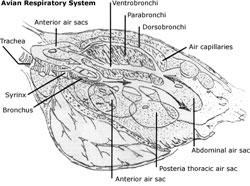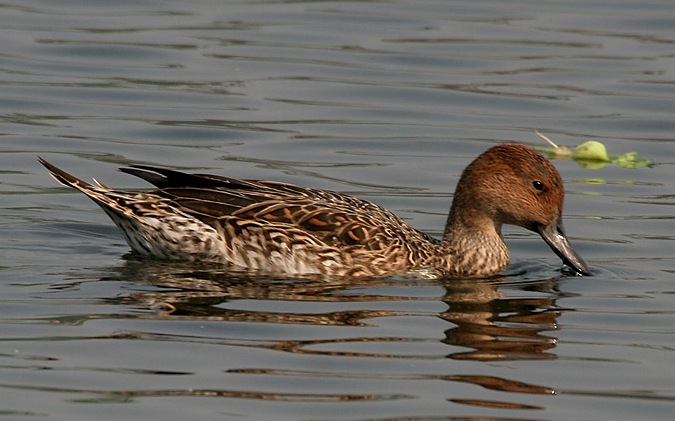Adaptation
The Northern Pintail, and all ducks in general, have many adaptations that make them so successful. They have developed certain traits to help them with:
Flying-
Of course the obvious adaptations for
flight would be wings and feathers. There
are two types of feathers on the wings of
ducks: the primary feathers that provide
thrust when flying and the secondary
feathers that help create lift due to
their specialized shape. If you've ever been
near a bird you know that the feathers are
smooth on top, allowing for the most
efficient airflow over their bodies making
them more efficient flyers. Another well
known adaptation is the bone structure of
birds. Their bones are hollow creating a
huge reduction in weight while still
providing necessary support via
honeycomb-like support structures. Where
humans have a sternum, ducks (and birds in
general) have a large structure called a
keel that allows a place for the giant
breast muscles needed for flying to attach.
Pintails go on extensive migrations and
therefore need a lot of oxygen supplied to these muscles. In order to do so birds have
a respiratory tract unrivaled by any other
organism. When a bird inhales air moves into
specialized structures call air sacks.
During inhalation the fresh air goes into
the posterior air sacks while the stale air
moves from the lungs to the anterior air
sacks. Then when the bird exhales air moves
from the posterior air sacks to the lungs
and the stale air moves out of the anterior
air sacks. This is combined with a strong
four chambered heart that pumps oxygenated
blood to the body and deoxygenated blood to
the lungs, very similar to the human heart,
to make an incredibly efficient circulatory
and respiratory system that allows them to
withstand the rigors of long migratory
flights.
these muscles. In order to do so birds have
a respiratory tract unrivaled by any other
organism. When a bird inhales air moves into
specialized structures call air sacks.
During inhalation the fresh air goes into
the posterior air sacks while the stale air
moves from the lungs to the anterior air
sacks. Then when the bird exhales air moves
from the posterior air sacks to the lungs
and the stale air moves out of the anterior
air sacks. This is combined with a strong
four chambered heart that pumps oxygenated
blood to the body and deoxygenated blood to
the lungs, very similar to the human heart,
to make an incredibly efficient circulatory
and respiratory system that allows them to
withstand the rigors of long migratory
flights.
Feeding-
The mouth of
dabbling ducks
are quite extraordinary. The edges of the
bill are soft and are used to feel for food
as they dip under the water surface. At the
end of the bill is a nail that they use to
manipulate their food. Ducks have an upper
and lower mandible and are very similar to
the structure of the human  jaw where the
mandible (lower mandible in the ducks) moves
up and down while the upper part of the
mouth is attached to the skeleton and
fixated in place. However instead of having
teeth, ducks have lamellae that filter
things like mud out so that only the food
finds its way into the stomach. The
mandibles of dabbling ducks usually have
about 50 to 70 of the comb-like structures
on each. Combine this with the especially
long neck of the Northern Pintail and you
can start to see why it is such an efficient
forager.
jaw where the
mandible (lower mandible in the ducks) moves
up and down while the upper part of the
mouth is attached to the skeleton and
fixated in place. However instead of having
teeth, ducks have lamellae that filter
things like mud out so that only the food
finds its way into the stomach. The
mandibles of dabbling ducks usually have
about 50 to 70 of the comb-like structures
on each. Combine this with the especially
long neck of the Northern Pintail and you
can start to see why it is such an efficient
forager.